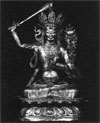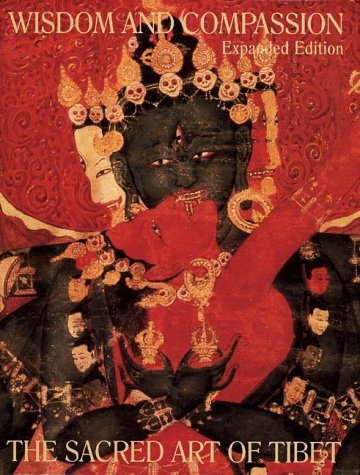Wisdom and Compassion: The Sacred Art of Tibet
By Marylin M. Rhie and Robert A. F. Thurman.
Photographs by John Bigelow Taylor.
Asian Art Museum of San Francisco and Tibet House, New York,
in association with Harry N. Abrams Inc., New York, 1991.
406 pp. $65.00 (hardcover)/$45.00 (paperback).
This volume is probably destined to be the locus classicus on Tibetan sacred art for our generation. In essays and comments by scholars from around the world accompanied by superb four-color plates, one hundred-sixty works of art are examined. These works of art exemplify the sacred history, religious institutions, and millennial vision of Tibetan Buddhism. Obviously it is extremely instructive. Equally instructive is what it omits to tell.
The catalog subsumes and amplifies the scholarship of Robert A. F. Thurman and Marilyn M. Rhie undertaken in connection with an exhibition held in 1984 at the Mead Art Museum, located in Amherst, Massachusetts. To this strong base are added notes by other scholars from Paris, Leningrad (St. Petersburg), and San Francisco. None is Tibetan. Professor Rhie’s art historical essay is scholarly, meticulous, and readable, as is Gille Beguin’s contribution on the technique of Tibetan art. But it is Robert A. F. Thurman who dazzles the reader with his rhapsodic, hortatory, and startling prose.
In his description of Tsong Khapa’s Great Prayer Festival in 1409, Thurman writes that during the several weeks of the festival “there was no difference between monk and layperson; the nation’s business was to pray and celebrate. . . . During that time. . . everyone could feel ordinary time stand still, and the whole society was lifted for a while into the realm of perfection, the Buddha Land, where wisdom and compassion were fully manifest to everyone.” Another section of Thurman’s essay, captioned “The Basics of Buddhism,” tells everything you’d like to pass on to the neophyte requesting an orientation. One can’t help feeling that the Buddhist precept in favor of “right speech” is realized in a discussion that brings to life the underlying principles that inform Buddhist practice.
On occasion, the language of description reaches a sort of self-parody of the art historical style, sounding then like the New York Times covering Paris fashion: “Reinforcing the taut dynamics of the body are the lively rhythmic arcs of the drapery that loosely but energetically enfold the figure.” But generally, these sometimes over-wrought descriptions serve to take the viewer-reader deeper and deeper into the work. An extremely useful glossary, bibliography, and index complete the volume.

The authoritative style of description, however, implies that matters under discussion are settled. Rarely, for example, is there a reference to divided opinion. The prose expresses a style associated with the writings of Western ethnographic art history. It prioritizes the object and addresses itself to a unitary, Occidental-centered viewer. Yet there are other ways to look at this work. Many of these artifacts were collected by self-styled European “explorers” during the nineteenth century. For example, Prince Esper Ukhtomsky (1861-1921) was known as the protector of Russian Buddhism. As a result he “had a unique opportunity to collect his Buddhist art directly from the people rather than through dealers, auctions, and conventional means. At that time he also had a practically unlimited choice of objects.” Ukhtomsky, like the other collectors represented in this show (Sven Hedin, Paul Pelliot, Sir Aurel Stein, Giuseppi Tucci, et al.), took an ethnographic and taxonomic approach to sacred art that were then being used (as they might still be) in dynamic religious practice. This scientism continues to affect the way the work is treated and discussed.
Gennady Leonov discusses, for example, the Russian State Hermitage’s practice of cataloging relics that have been removed from various statues. In their origin, these relics are placed in images of deities as part of an elaborate ritual of consecration, which causes the actual deity depicted to descend into and inhabit the work. The Russian discussion of these objects concentrates on numerical values: protection wheels were found in thirty-five sets of relics but only thirty-nine sets contained axis poles, and so on. “This research permits the systematization of relics…according to topological groups compiled of all the items of the same type.” This attitude would be very foreign to the artisans who created, consecrated, and worshiped in the presence of the objects. And this disparity reveals our own cultural biases at work in shaping the discourse.
These essays would be very different if they addressed other concerns: What were the intentions and conditions of the craftsmen who made these objects? How did any given object come to be uprooted from its ancestral location? What was the trajectory of its voyage from original home to plexiglass box in a San Francisco museum? Who smelted the gold, mined the gems, wove the cotton involved? What was the daily life of the “fabricator of gods” like? (Lama Zanzabar, the seventeenth-century Mongolian sculptor, is one of the few artisans identified, or capable of being identified, in the show. Might one hypothesize about his life?) What are the stories of the so-called explorers and of how they came to gather this work? These are questions congenial to the Buddhist. They point to the interpenetrating nature of reality, which is the point of Tibetan Madyamika (Middle Way, or Centrist) philosophy. The catalog, necessarily, represents an arbitrary and selective view of our connection to this exhibit. Let us note that the selection says as much about our culture as about Tibetan sacred art.
This may be to cavil. Like the show itself, the catalog is studded with jewels. For example, there is unexpected depth in the essay that discusses “Shakyamuni Buddha with Scenes of His Former Lives.” Here ten stories from the Jatakamala are retold with inscriptions newly translated by Lobsong Lhalungpa of Santa Fe. In words and image, this section alone might be expanded to a complete volume for children.
For me the most telling point in the catalog is made by Thurman. In his view, the ongoing laicization of global culture has “disenchanted” our civilization. For the resulting “secularized society living in the material world (this is) the only form of modernity we can imagine.” Tibetan culture, by contrast, being wholly monasticized, offers an alternative worldview. The organizers of this show are champions of that alternative perspective. And they have made political decisions about what to highlight in an effort to direct world attention to the plight of modern Tibet. It is hard to imagine failing to support this intention; but to conflate a certain political agenda with alleged art historical objectivity should invite our thoughtful regard.
Thank you for subscribing to Tricycle! As a nonprofit, we depend on readers like you to keep Buddhist teachings and practices widely available.
